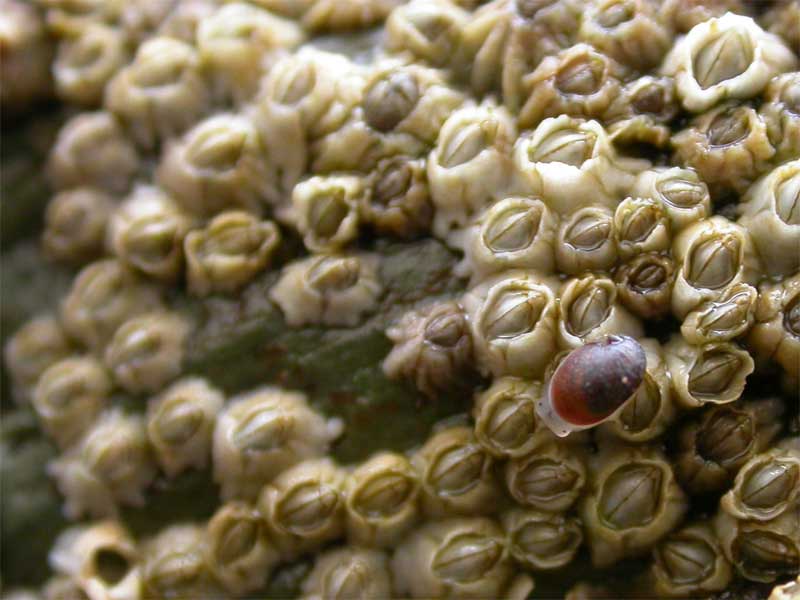Ear-shaped shell (Otina ovata)
Distribution data supplied by the Ocean Biodiversity Information System (OBIS). To interrogate UK data visit the NBN Atlas.Map Help
| Researched by | Eliza Gibson-Hall | Refereed by | This information is not refereed |
| Authority | (T. Brown, 1827) | ||
| Other common names | - | Synonyms | Otina otis |
Summary
Description
The ear-shaped shell is one of the few marine air-breathing gastropods found near the high water mark in north-west Europe. It resembles a tiny limpet with one distinctive large shell compartment (or whorl). The shell is semi-transparent, oval, and usually up to only 2 mm in length. ‘Ear-shape’ refers to the shape of the shell aperture, which also has a pale, curved, outer lip. The shell exterior is smooth in appearance and the interior is glossy with no umbilicus. The shell is reddish-brown to purple in colour, but rare white specimens are found.
Recorded distribution in Britain and Ireland
Recorded along the west coast of Scotland, south-west of England, south and north Wales, the Isle of Man, and the west coast of Ireland.
Global distribution
Recorded from the coasts of the British Isles, Belgium and northern France.
Habitat
They are restricted to humid, shaded areas at high water, usually in rock crevices, caves, and the small niches formed by empty barnacle shells.
Depth range
Upper shoreIdentifying features
- Up to 2 mm in length
- Shell and aperture ear-shaped
- Reddish-brown to purple
- Cannot withdraw body entirely into the shell
Additional information
Otina ovata requires humid air, of near to 100%, in order to survive. If unable to find a humid location they clamp down on rocks, similar to a limpet. They do not survive under extended periods of submergence (12-hour cycle) and are, therefore, limited to the high water mark. They prefer humid, shaded crevices with a smooth surface along the higher intertidal. This can include moist caves but they favour cracked rock or empty barnacle tests (Morton, 1954). They are inconspicuous due to the small size and specialised habitat and may be under-recorded. However, they often occur in groups of around 10 individuals to preserve moisture. They are usually recorded in the Chthamalus zone (Chthamalus stellatus) (Morton, 1954).
Listed by
Bibliography
De Kluijver, M.J., 1993. Sublittoral hard-substratum communities off Orkney and St Abbs (Scotland). Journal of the Marine Biological Association of the United Kingdom, 73 (4), 733-754.
- Morton, J.E., 1954. The crevice faunas of the upper intertidal zone at Wembury. Journal of the Marine Biological Association of the United Kingdom, 33 (1), 187-224. DOI: 10.1017/S0025315400003568
- Morton, J.E., 1955. The functional morphology of Otina otis, a primitive marine pulmonate. Journal of the Marine Biological Association of the United Kingdom, 34 (1), 113-150. DOI: https://doi.org/10.1017/S002531540000864X
Datasets
Conchological Society of Great Britain & Ireland, 2018. Mollusc (marine) data for Great Britain and Ireland - restricted access. Occurrence dataset: https://doi.org/10.15468/4bsawx accessed via GBIF.org on 2018-09-25.
Conchological Society of Great Britain & Ireland, 2023. Mollusc (marine) records for Great Britain and Ireland. Occurrence dataset: https://doi.org/10.15468/aurwcz accessed via GBIF.org on 2024-09-27.
Fenwick, 2018. Aphotomarine. Occurrence dataset http://www.aphotomarine.com/index.html Accessed via NBNAtlas.org on 2018-10-01
NBN (National Biodiversity Network) Atlas. Available from: https://www.nbnatlas.org.
OBIS (Ocean Biodiversity Information System), 2025. Global map of species distribution using gridded data. Available from: Ocean Biogeographic Information System. www.iobis.org. Accessed: 2025-07-19
South East Wales Biodiversity Records Centre, 2018. SEWBReC Molluscs (South East Wales). Occurrence dataset: https://doi.org/10.15468/jos5ga accessed via GBIF.org on 2018-10-02.
Citation
This review can be cited as:
Last Updated: 04/07/2018



